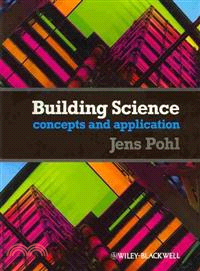Building Science ─ Concepts and Application
商品資訊
ISBN13:9780470655733
出版社:JOHN WILEY & SONS;LTD
作者:POHL
出版日:2011/02/04
裝訂/頁數:平裝/280頁
規格:25.4cm*17.8cm*1.9cm (高/寬/厚)
商品簡介
The first section explores the thermal building environment and the principles of thermal comfort, translating these principles into conceptual building design solutions. The author examines the heat flow characteristics of the building envelope and explains steady state design methods that form the basis of most building codes. He discusses the sun as a natural heat source and describes the principles of active and passive solar building design solutions.
The second section introduces the scientific principles of light, color, and vision, stressing the importance of daylight in building design, presenting the Daylight Factor design concept and methodology, and discussing glare conditions and their avoidance. It also addresses artificial lighting, delving into the prominent role that electricity plays in the production of light by artificial means and comparing the efficacy and characteristics of the various commercially available light sources in terms of the energy to light conversion ratio, life span, available intensity range, color rendition properties, and cost.
The third section deals with the various aspects of sound that impact the design of the built environment, discussing the nature of sound as a physical force that sets any medium through which it travels into vibration and laying the foundations for the treatment of sound as an important means of communication as well as a disruptive disturbance.
The final section discusses the foundational concepts of ecological design as a basis for addressing sustainability issues in building design solutions. These issues include the embedded energy of construction materials, waste management, preservation of freshwater and management of graywater, adoption of passive solar principles, energy saving measures applicable to mechanical building services, and the end-of-lifecycle deconstruction and recycling of building materials and components.
- Covers the fundamental building science topics of heat, energy, light and sound
- Takes a logical and didactic approach, tracing the historical roots of building science
- Includes summaries of new technologies in solar energy and photovoltaic systems
- Features a section on the principles of sustainable architecture
- Website with answers to MC questions testing students' learning
作者簡介
目次
1 Technical Underpinnings in Mathematics and Physics.
1.1 Linear equations.
1.2 Some statistical methods.
1.3 Foundational concepts in physics.
2 Principles of Thermal Comfort.
2.1 Heat transfer between body and environment.
2.2 Some physiological considerations.
2.3 More about individual differences.
2.4 Measurement of the thermal environment.
2.5 Selecting the appropriate index.
2.6 Thermal comfort factors.
3 Thermal Control by Building Design.
3.1 How important is the thermal environment?
3.2 Thermal building design strategies.
3.3 Importance of sunshading devices.
3.4 Radiation through roofs.
3.5 Sun position and orientation.
3.6 Solar design steps.
3.7 Achieving air movement naturally.
3.8 Removal of heat by ventilation.
4 Heat Flow and Thermal Insulation.
4.1 The need for energy conservation.
4.2 How is heat transferred?
4.3 Steady-state heat-transfer assumptions.
4.4 The nature of thermal conductivity.
4.5 Building heat-fl ow calculations.
4.6 Energy conservation standards.
4.7 Insulation and insulating materials.
4.8 The cause and nature of condensation.
4.9 Heat-fl ow calculation example.
5 Solar Energy: The Beckoning Opportunity.
5.1 Opportunities and limitations.
5.2 Two types of solar collection system.
5.3 Flat-plate solar collectors.
5.4 Solar heat-storage systems.
5.5 Sizing a solar hot-water service.
5.6 The degree–day concept.
5.7 Sizing a solar space-heating system.
5.8 Integrating building structure and heat storage.
5.9 Passive solar systems.
6 Light, Color, and Vision.
6.1 Some historical background.
6.2 Light speed and color.
6.3 What is light?
6.4 Light viewed as mechanical waves.
6.5 Measurement units of light.
6.6 Light refl ection, absorption, and transmission.
6.7 The visual field and adaptation level.
6.8 Perceptional constancy.
6.9 The nature of glare.
7 Daylight Design Principles.
7.1 Variability of daylight.
7.2 Quality of daylight and color.
7.3 How much daylight is available?
7.4 Measurement of daylight.
7.5 Model analysis.
7.6 The daylight factor concept.
7.7 Glare from daylight.
8 Artifi cial Lighting.
8.1 Definition of terms.
8.2 Creation of light artificially.
8.3 Functions of the luminaire.
8.4 Light fixtures.
8.5 The lumen method of lighting design.
8.6 The room cavity ratio.
8.7 The PSALI concept.
9 The Nature of Sound.
9.1 What is sound?
9.2 Objective units of sound measurement.
9.3 Addition, deletion, and reduction of sound pressure levels.
9.4 The concept of octave bands.
9.5 Subjective units of sound measurement.
9.6 How do we hear sound?
9.7 Hearing conservation in the environment.
9.8 Sound-measurement instruments.
10 Room Acoustics.
10.1 Refl ection and diffraction of sound.
10.2 Absorption of sound.
10.3 Speech communication.
10.4 Halls for speech and music.
11 Noise Control and Insulation.
11.1 Noise control by legislation.
11.2 Airborne and solid-borne sound.
11.3 Airborne noise insulation.
11.4 Solid-borne noise insulation.
11.5 Noise insulation in practice.
11.6 Common noise sources.
12 Sustainable Architecture Concepts and Principles.
12.1 Human resistance to change.
12.2 Discernible trends.
12.3 Fundamental concepts and definition of terms.
12.4 Assessment of high-performance buildings.
12.5 Energy design strategies.
12.6 Water conservation strategies.
12.7 Closed-loop building materials.
References and Further Reading.
Keyword Index.
主題書展
更多書展您曾經瀏覽過的商品
購物須知
外文書商品之書封,為出版社提供之樣本。實際出貨商品,以出版社所提供之現有版本為主。部份書籍,因出版社供應狀況特殊,匯率將依實際狀況做調整。
無庫存之商品,在您完成訂單程序之後,將以空運的方式為你下單調貨。為了縮短等待的時間,建議您將外文書與其他商品分開下單,以獲得最快的取貨速度,平均調貨時間為1~2個月。
為了保護您的權益,「三民網路書店」提供會員七日商品鑑賞期(收到商品為起始日)。
若要辦理退貨,請在商品鑑賞期內寄回,且商品必須是全新狀態與完整包裝(商品、附件、發票、隨貨贈品等)否則恕不接受退貨。














